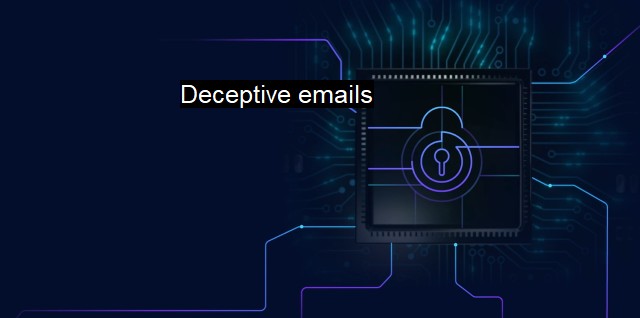What are Deceptive emails?
Beware of Deceptive Emails: The Increasing Threat to Cybersecurity and Antivirus Protection
Deceptive emails, often referred to as phishing or spoofing, is a cyber security threat where cybercriminals use misleading or forged email addresses and personal information to trick email recipients into performing actions, such as sharing highly sensitive personal information or clicking on malicious URLs. The person receiving such an email may be led into believing that they are dealing with a trusted party, usually one whom they recognize or do business with on a regular basis.As security measures have improved, deceptive emails have evolved to become highly sophisticated. Modern deceptive emails often have a real-looking email address, have carefully crafted content mimicking legitimate organizations, and may even adopt personalized greetings or use personal information obtained from various sources to look authentic. In some cases, cybercriminals recreate almost the exact replicates of legitimate websites to fool unsuspecting victims, a strategy commonly known as "website spoofing".
Deceptive emails can be perilous as they have emerged as a viable mechanism for distributing ransomware, malware, and conducting various scams. Phishing, a type of deceptive email scam, involves luring the recipient into revealing sensitive information such as credit card numbers, bank account information, Social Security numbers, and login credentials. This kind of information can be further used by attackers to commit identity fraud.
The malicious intent is not always immediate or direct. In some cases, the deceptive email contains links or attachments that, if clicked on or opened, can install malicious software onto the device. This software often runs covertly in the background, collecting and transmitting personal and corporate information, tracking activities and even controlling remote access to the device.
Anti-virus and security awareness trainings are effective steps against deceptive emails. Countering these threats involves keeping security systems updated, combined with training to increase awareness of the latest deceptive email techniques. Available methods for detecting deceptive emails include manual verification of an email’s return address or embedded links, using antivirus software that can scan emails for known virus signatures, and deploying artificial intelligence techniques to spot unusual email patterns.
A paradigm shift towards understanding how deceptive emails are conceived and structured provides unmatched foresight while designing cybersecurity solutions. It's also important to teach internet users about safe browsing habits and the risks of sharing information with unverified sources. They should be educated on how professional businesses communicate, and that such businesses will never request sensitive information over email.
In the broader context of cybersecurity, fighting deceptive emails underscores the important axiom that "human are the weakest link." Cybersecurity tools alone aren't enough. Instilling a mindset of vigilance and suspicion when dealing with online communication is a critical countermeasure. For organizations, security policies and procedures need to mandate practices to validate email authenticity.
Certainly, cybercriminals are continuously evolving their techniques due to advancements in cybersecurity. This battle sees no end, with cybersecurity continually locking horns with these threats. Emerging technologies including AI and Machine Learning are being roped in to aid cybersecurity and antivirus solutions.
It's crystal clear that the effective fight against deceptive emails requires more than just technology; it requires a combination of education, awareness, and policy management alongside the latest cybersecurity arsenal. A robust cybersecurity infrastructure backed up by informed and vigilant users forms the most dependable line of defense against deceptive emails. This multi-dimensional approach is pivotal in extinguishing the flames that deceptive emails stoke in the realm of digital social engineering.

Deceptive emails FAQs
What are deceptive emails?
Deceptive emails are fraudulent messages designed to appear as legitimate communications. These emails may contain text, images, or links that trick the recipient into divulging sensitive information such as passwords or financial information.How can I identify a deceptive email?
Deceptive emails often contain spelling and grammatical errors, suspicious or unfamiliar sender email addresses, and urgent or threatening language. They may also contain attachments or links that lead to fake login pages or malware-infected websites.What should I do if I receive a deceptive email?
If you receive a suspicious email, do not click on any links or download any attachments. Instead, delete the message and report it to your organization's IT department or the relevant authorities, such as the Federal Trade Commission.How can I protect myself from deceptive emails?
To protect yourself from deceptive emails, use anti-virus software, phishing filters, and spam blockers. Additionally, be cautious when opening emails from unknown or suspicious senders, and avoid clicking on links or downloading attachments unless you are certain of their legitimacy.| | A | | | B | | | C | | | D | | | E | | | F | | | G | | | H | | | I | | | J | | | K | | | L | | | M | |
| | N | | | O | | | P | | | Q | | | R | | | S | | | T | | | U | | | V | | | W | | | X | | | Y | | | Z | |
| | 1 | | | 2 | | | 3 | | | 4 | | | 7 | | | 8 | | |||||||